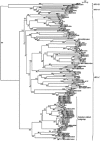Human rhinovirus C: a newly discovered human rhinovirus species
- PMID: 22460392
- PMCID: PMC3167658
- DOI: 10.3134/ehtj.10.002
Human rhinovirus C: a newly discovered human rhinovirus species
Abstract
Although often ignored, human rhinoviruses (HRVs) are the most frequent causes of respiratory tract infections (RTIs). A group of closely related novel rhinoviruses have recently been discovered. Based on their unique phylogenetic position and distinct genomic features, they are classified as a separate species, HRV-C. After their discovery, HRV-C viruses have been detected in patients worldwide, with a reported prevalence of 1.4-30.9% among tested specimens. This suggests that the species contribute to a significant proportion of RTIs that were unrecognized in the past. HRV-C is also the predominant HRV species, often with a higher detection rate than that of the two previously known species, HRV-A and HRV-B. HRV-C infections appear to peak in fall or winter in most temperate or subtropical countries, but may predominate in the rainy season in the tropics. In children, HRV-C is often associated with upper RTIs, with asthma exacerbation and wheezing episodes being common complications. The virus has also been detected in children with bronchitis, bronchiolitis, pneumonia, otitis media, sinusitis and systemic infections complicated by pericarditis. As for adults, HRV-C has been associated with more severe disease such as pneumonia and exacerbation of chronic obstructive pulmonary disease. However, larger clinical studies with asymptomatic controls are required to better define the significance of HRV-C infection in the adult population. On the basis of VP4 sequence analysis, a potential distinct subgroup within HRV-C has also been identified, although more complete genome sequences are needed to better define the genetic diversity of HRV-C.
Conflict of interest statement
The authors declare no conflict of interest.
Figures

References
-
- Kaiser L, Aubert JD, Pache JC, Deffernez C, Rochat T, Garbino J, et al. Chronic rhinoviral infection in lung transplant recipients. Am J Respir Crit Care Med. 2006;174:1392–9. - PubMed
-
- Turner RB. Rhinovirus: more than just a common cold virus. J Infect Dis. 2007;195:765–6. - PubMed
-
- Laine P, Savolainen C, Blomqvist S, Hovi T. Phylogenetic analysis of human rhinovirus capsid protein VP1 and 2A protease coding sequences confirms shared genus-like relationships with human enteroviruses. J Gen Virol. 2005;86:697–706. - PubMed
LinkOut - more resources
Full Text Sources
Research Materials
Miscellaneous
